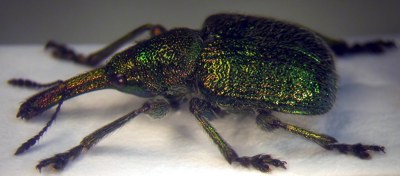Pests
Rhynchytes giganteus Kryn. - Large Pear Weevil.
Systematic position.
Class Insecta, Order Coleoptera, Family Rhynchitidae, Genus Epirhynchytes Voss.Synonyms.
Epirhynchytes giganteus Kryn.Biological group.
Primarily a pest of pear. Pest of apple to a lesser degree.Morphology and biology.
The largest orchard pest of the rhynchites species in the former USSR. Body length reaches 6.5-11 mm. Integument is copper with metallic shine. Apical part of rostrum, antennae, and tarsi dark brown with purple tint. Rostrum parallel-sided; rostral dorsum with thin median carina extended from rostrum base to antennal base. 1st and 2nd antennal segments equal in length. Eyes large, ovate, slightly convex; the greatest diameter of eyes is nearly half the width of the frons. Pronotum slightly elongated, without lateral thorn. Scutellum small, quadrangular. Punctation of elytra rugose and irregular; interstriae usually convex. Body covered with long, light hairs. Pronotum of the last larva instar has 2 transversal, yellowish spots in middle part. Adults and larvae hibernate in soil. Adults appear after hibernation before beginning of pear blossoming. They feed on buds and leaves, later on flowers, green shoots, and fruits. Oviposition occurs in June-July. Female gnaws a hole in fruit, puts a white ovate egg inside at the bottom, covering it with chewed-up pith of fruits. Then the female gnaws a sinuous groove on the fruit surface around the egg chamber and gnaws fruit stem. Several eggs can be laid in one fruit. Fertility approaches 160 eggs. Eggs develop in 8-12 days. Infested fruits fall to earth, rot, or shrivel. Larva develop in 30-60 days, devouring seeds and seed chambers; then the larva leaves fruit in soil and makes a cradle for pupation at a depth of 15 cm. Larvae diapause lasts through the winter and the next summer. Pupation and emergence of young beetles occur in autumn, but adults remain inside cradles until spring.Distribution.
Inhabits southern and central Europe, Turkey, and northern Iran. In the former USSR, it is widely distributed in Moldavia and Ukraine; throughout the Smolensk, Kursk, Voronezh, Volgograd and Astrakhan Regions of Russia; everywhere in the Caucasus; and in Uzbekistan.Ecology.
Development of one generation continues for 2 years. Two peaks of the adults. abundance are observed at the end of April and the beginning of May through the second third of June.Economic significance.
This species is the most dangerous pest of solitary pear trees and of marginal trees along boundaries of orchards.Related references:
Dobrovol'skii, B.V. 1951. Harmful beetles. Rostov-na-Donu: Rostizdat. 455 p. (in Russian).Gulii, A.P. 1962. Roller-weevils and weevils in orchards of northern slope of Central Caucasus. In: Questions of ecology of land invertebrates. V. 4. Moscow: Vysshaya shkola: 45-46 (in Russian).
Khalilov, B.B. 1960. Large Pear Fruit Rhynchites (Rhynchites giganteus Kryn.) as a pest of apple. Bulletins of scientific-technical information of Azerbaijan Institute of Plant Protection. Kirovabad: 33-34.
Kryzhanovskii, O.L., ed. 1974. Pest insects and mites of agricultural plants, V. 2. Leningrad: Nauka. 335 p. (in Russian).
Legalov, A.A. 2003. Taxonomy, classification and phylogeny of the leaf-rolling weevils (Coleoptera: Rhynchitidae, Attelabidae) of the world fauna. Novosibirsk. CD-ROM and Web-site. http:// attelabidae.narod.ru/System_of_rhynchitidae.htm (in English & Russian).
Savkovskii, P.P. 1976. Atlas of the pests of fruit and berry plants. Kiev: Urozhai. 207 p. (in Russian).
Ter-Minasyan, M.E. 1950. Roller-weevils (Attelabidae). Fauna of the USSR. Insecta - Coleoptera, 27(2). Moscow & Leningrad: AN SSSR, 231 p. (in Russian).
Vasil'ev V.P., 1955. Pests of fruit crops. Kiev: AN Ukr. SSR. 265 p. (in Russian).
Vasil'ev V.P., Lifshits I.Z., 1984. Pests of fruit crops. Moscow: Kolos. 399 p. (in Russian).


